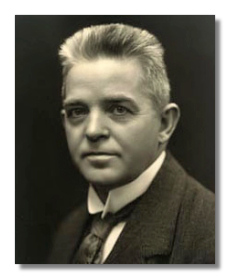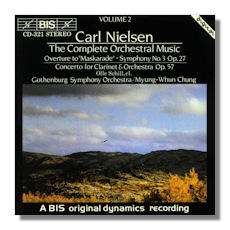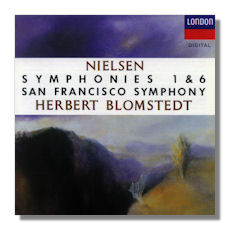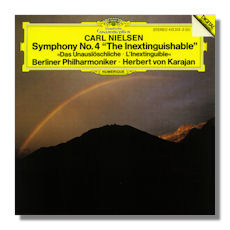
The Internet's Premier Classical Music Source
Related Links
-
Find CDs & Downloads
Amazon - UK - Germany - Canada - France - Japan
ArkivMusic - CD Universe
Find DVDs & Blu-ray
Amazon - UK - Germany - Canada - France - Japan
ArkivMusic-Video Universe
Find Scores & Sheet Music
Sheet Music Plus -
- Danish Nielsen Society
- Carl Nielsen Collection
at the Copenhagen Royal Library - Chronological Works List
by Andrew Jackson - Carl Nielsen
by Knud Ketting - Carl Nielsen
by Ray Ashley
Recommended Links
Site News
Carl Nielsen

(1865 - 1931)
Carl August Nielsen (June 9, 1865 - October 3, 1931) grew up in the countryside of the Danish island of Fyn (Funen), his parents poor but artistic. His father, Niels Jørgensen named his son according to old Danish custom ("Niels's son"), painted houses for a meager living, and was an amateur musician. His mother was also musical. The family lived in such straightened circumstances that several of Nielsen's siblings as well as, briefly, his parents emigrated to the United States Midwest. Carl had to earn his living. He became apprenticed to a grocer and hated it. He then joined a military band where he played signal horn and trombone, both of which he learned in order to get the gig. He was also an accomplished violinist. The boy's talent was noticed, and he was sent to the Copenhagen Conservatory on scholarship. A lackluster student, he did little at the conservatory, although his violin playing improved, and he received a solid grounding in fundamental technique – harmony and counterpoint. He also studied composition with the grand old man of Danish music and head of the conservatory, Niels Gade, the friend of Schumann. Nielsen admired Gade the man but not the composer. Gade's music became a symbol of something to avoid.
After graduating, Nielsen became a second violinist in orchestra of the Danish Royal Opera, where he worked for eighteen years. His compositions began to get played. Less than a year after joining the opera, he received a grant to study for several months in other countries. He heard, admired, and finally rejected Wagner's operas, all in an incredibly short time, and sharpened his views of the music he wanted to write. He arrived at his ideals by rejecting most of what was out there. He disliked the extreme subjectivity and sentimentality of much of Romantic music, preferring composers like Bach, Mozart, and Haydn. In the Brahms-vs.-Wagner fight, he came down on the side of Brahms. Again, during these few months, he met and married Anne Marie Brodersen, who became the leading sculptor of her day. Their marriage had its strains, at one point leading to separation and reconciliation. She was often away, attending to commissions, and Nielsen was unfaithful. She may have been as well. Nevertheless, each remained the other's closest artistic advisor.
After an early period of chamber music, which he could get his friends to play, Nielsen began to write incidental music, something that paid and supplemented his income. Concert works appeared and stirred up controversy in musically-conservative Copenhagen. Indeed, Nielsen attained his "official" status only late in life, and even then critics sniped at his new work, while generously accepting earlier pieces they had panned before. Nevertheless, the government, eager to foster Danish art as a matter of Danish pride, settled a small state pension on him in the early 1900s. He also began to conduct and longed for a permanent post. He was, although often an inspired conductor, politically unadept as well as technically insecure. Beginning in 1915, he began to teach theory and composition at the Conservatory and became part of that institution's board of governors.
In 1926, Nielsen suffered a major heart attack and never fully recovered his health. He died of heart failure in 1931.
The Suite for Strings, Op. 1 (1889) reflects Nielsen's chamber-music roots – charming, intimate, following in the footsteps of such Scandinavian composers as Grieg. However, Brahms becomes an early model for Nielsen, but with a difference, reflected in the Symphony #1 in g (1892). We see a composer with a feeling for dramatic form, but little sloppy sentiment. The symphony exhibits traits associated with most of Nielsen's music: an athleticism, an emotional coolness but still powerful, and what I would call the music of bees – a tuning into the energy and hum of the natural world. There's also an individual approach to tonality – a dramatic use of keys, almost in a symbolic manner. The Symphony #1 moves fluidly among the key centers of G, Eb, and C (outlining a c-minor chord, if you care). Indeed, tonality overall, though present, is ambiguous. I believe Nielsen picked up the idea of this from Beethoven, especially the Piano Concerto #4 finale, where the opening theme begins in C and ends in G. However, Nielsen takes this key-morphing much farther.
The Symphony #2, "The Four Temperaments" (1902), is a lighter affair. On the walls of a country inn, Nielsen saw cartoons of the humorous types: choleric, phlegmatic, melancholic, and sanguine. The lightness is merely relative, however. Nielsen seeks to make his music a vehicle of humanistic idealism. Technically, the two outer movements use contrast to create drama, as if both the choleric and the sanguine follow contradictory impulses, while the inner movements explore a single mood. Nielsen continued down these two paths. The outer movements lead to works like the Fourth, Fifth, and Sixth Symphonies (1916, 1922, and 1925, respectively), while the inner ones lead to experiments in "suspending time," in works like the Helios Overture (1903), the Symphony #3 "Sinfonia espansiva" (1903) with its rapt vocalises for soprano and baritone, and Saga-drøm (1908).
Critics of Nielsen's symphonies talk about his use of "progressive" or "emergent" tonality. In the Fifth Symphony, for example, the first movemment pits two keys against each other and has them fight it out as to which survives. The second movement resolves this conflict for a third option, which "emerges." I think of it slightly differently, in a dramatic way. Unlike traditional tonality which tends to mark large architectural blocs of a work, Nielsen's "progression" of keys serves a rhetorical or even symbolic function. The tonality becomes something active rather than spatial or a part of listener orientation.
Nielsen's interest in drama extended to the theater. His two operas, Saul and David and Maskarade, one serious, the other comic, are unaccountably-neglected masterpieces, full of insight and, in the latter opera, good humor, with a Falstaffian tolerance for human folly. The latter has achieved the status of Danish National Opera, but it's not much known outside Denmark. The same thing goes for Saul and David, a psychological study so penetrating that you could argue the work has two heroes. The Royal Opera grudgingly put them on, and at their success within Denmark, nevertheless summarily removed them for a long time from their seasons. This stung Nielsen, who after all had played in the opera orchestra for 18 years, and he resolved never to write for them again. He did break his promise, but not with another opera. This was the incidental music to Aladdin (1919), a score they begged him to write and then snubbed after the initial run.
For me, the Third Symphony inaugurates Nielsen's transformation from late Romantic to Modern, especially in the slow movement. However, the so-called "war" symphonies (#4 and 5) admittedly show this more clearly, especially in their more advanced harmonies, bolder dissonances, and tremendously exciting use of "dueling" percussion. One should mention that Nielsen's success in Denmark during his lifetime was never all the great, although he had his pockets of influential admirers. His music did much better in Sweden, where he had the advocacy of Stenhammar, among others. Professional jealousies among Danish musicians contributed to Nielsen's problems. The Sixth Symphony "Sinfonia semplice," however, was anything but. Psychologically elusive, it sowed confusion even among Nielsen's friends and continues to do so today. It has remained controversial.
Nielsen excelled in chamber music as well, although his string quartets are more "social occasions" than spiritual testaments. More interesting and artistically more ambitious are his violin sonatas, the Serenata in vano (1914) and Wind Quintet (1922). The Wind Quintet led to Nielsen's late concertos, for flute (1926) and clarinet (1928). Nielsen planned to create concerti for each performer who took part in the quintet's premiere. Death put paid to this idea, but these two concerti – among his best scores – have entered the standard repertory of flautists and clarinetists. His last major score, Commotio for organ (1931), shows renewed emphases on counterpoint and new directions, cut short, of course, by Nielsen's death.
Sibelius overshadowed Nielsen for several decades. Few major conductors took him up, except for those, like Horenstein, who had careers in Scandinavia, which, with few exceptions, has always lain slightly under critical gaze. Kierkegaard, for example, was first translated into English in the Forties. Robert Simpson's Carl Nielsen: Symphonist (1952), which proved enormously influential, brought the composer to notice outside Scandinavia. In the mid-Sixties, approximately a century after his birth, Bernstein began to champion him, with blockbuster recordings of the Fifth and Third Symphonies. These mark Nielsen's entry into the international repertoire. ~ Steve Schwartz
Recommended Recordings
Concerto for Clarinet
Sheet Music for this Piece
- Clarinet Concerto, Op. 57; Symphony #3, Maskarade/BIS CD-321 or CD-616
-
Olle Schill (clarinet), Myung-Whun Chung/Gothenburg Symphony Orchestra
Amazon - UK - Germany - Canada - France - Japan - ArkivMusic - CD Universe
Or BIS CD-616 - Concertos
Amazon - UK - Germany - Canada - France - Japan - ArkivMusic - CD Universe - Clarinet Concerto, Op. 57 w/ Lutosławski & Copland/Chandos CHAN8618
-
Janet Hilton (clarinet), Matthias Bamert/Scottish National Orchestra
- Clarinet Concerto, Op. 57 w/ Aho/BIS Hybriad Multichannel SACD SACD-1463
-
Martin Fröst (clarinet), Osmo Vänskä/Lahti Symphony Orchestra
 Symphonies (1-5)
Symphonies (1-5)
Sheet Music for this Piece
- Symphonies #1, Op. 7 and #6 "Sinfonia semplice", Op. 116/London 425607-2
-
Herbert Blomstedt/San Francisco Symphony Orchestra
- Symphonies #1, Op. 7 and #4 "The Inextinguishable", Op. 29/RCA Red Seal 7701-2-RC
-
Paavo Berglund/Royal Danish Orchestra
Amazon - UK - Germany - Canada - France - Japan - ArkivMusic
Or RCA 20290-2
Amazon - UK - Germany - Canada - France - Japan - ArkivMusic - CD Universe - Symphony #2 "The Four Temperments", Op. 16; Aladdin/BIS CD-247
-
Myung-Whun Chung/Gothenburg Symphony Orchestra
- Symphony #3 "Sinfonia espansiva", Op. 27/BIS CD-321
-
Myung-Whun Chung/Gothenburg Symphony Orchestra
- Symphonies #4 "The Inextinguishable", Op. 29 and #5, Op. 50/London 421524-2
-
Herbert Blomstedt/San Francisco Symphony Orchestra
- Symphony #4 "The Inextinguishable", Op. 29/Deutsche Grammophon 413313-2
-
Herbert von Karajan/Berlin Philharmonic Orchestra
- Symphony #5, Op. 50; Violin Concerto/BIS CD-370
-
Myung-Whun Chung/Gothenburg Symphony Orchestra
















